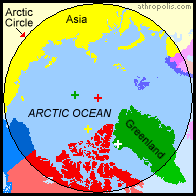
 Four North Poles? There are four "North Poles" that can be defined in the Arctic: + Geographic North Pole (also known as True North): The northernmost point of the Earth as determined by the northern axis of its rotation. It has a known fixed position, at latitude 90° North. + Magnetic North Pole: A moving location where lines of magnetic force enter and exit the Earth vertically. The north point of a magnetic compass points to this pole. It's location was discovered by James Clark Ross in 1831. + Geomagnetic North Pole: The pole of the Earth's geomagnetic field that surrounds the Earth and extends into space as the magnetosphere. This is the centre of the region in which the Northern Lights can be seen. + North Pole of Inaccessibility: At approximately 85°N-175°W, this represents the point on the surface of the Arctic Ocean which is the farthest distance (about 1100 km / 684 miles) from any coastline.
Click pictures for more information and credits. Library: Arctic, Northern Lights People/Explorers, Exploration Links: Arctic, Northern Lights Arctic Maps & Weather Reports Northern Lights SLIDE SHOW |

|
DICTIONARY: Just "double-click" any unlinked word on this page for the definition from Merriam-Webster's Student Electronic Dictionary at Word Central. |

|
ARCTIC LIBRARY & GLOSSARY: Check this section for an index of the rest of the things you really need to know about the Arctic. |

|
ARCTIC MAPS & WEATHER REPORTS: Maps of the Northwest Passage, explorers' routes, iceberg sources, Nunavut, the Arctic by treeline, temperature... |

|
ARCTIC LINKS: Even more information! Links to sites related to the Arctic and "Iceberg: the Story of the Throps and the Squallhoots". |

|
GUIDE TO ARCTIC SUNRISE & SUNSET: How much sunlight or darkness is there in the Arctic on each day of the year? |
to is the property of their respective owners, and Athropolis is not responsible for their content.